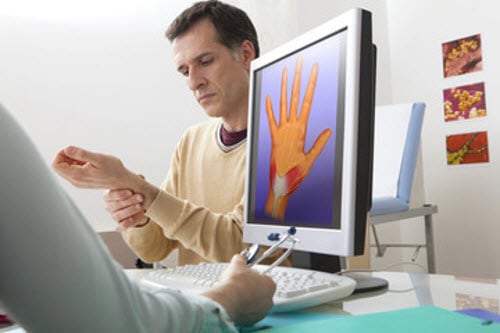
Carpal Tunnel Syndrome
Carpal Tunnel Syndrome is a common condition that affects the hand and wrist. It occurs when the median nerve, which runs from the forearm into the hand, becomes compressed or squeezed at the wrist. This compression can cause a variety of symptoms, including pain, numbness, and tingling in the hand and fingers.
The main cause of Carpal Tunnel Syndrome is the narrowing of the carpal tunnel, a narrow passageway in the wrist that protects the median nerve and tendons. This narrowing can be caused by a variety of factors, including repetitive hand and wrist movements, such as typing or using a computer mouse, as well as certain medical conditions, such as arthritis or diabetes.
The symptoms of Carpal Tunnel Syndrome can vary depending on the stage of the condition. In the early stages, individuals may experience occasional numbness or tingling in the hand and fingers, especially at night. As the condition progresses, these symptoms may become more frequent and may be accompanied by pain or weakness in the hand and wrist.
Several risk factors can increase the likelihood of developing Carpal Tunnel Syndrome. These include being female, having a family history of the condition, and having certain medical conditions, such as diabetes or arthritis. Additionally, individuals who perform repetitive hand and wrist movements as part of their job or hobbies may also be at an increased risk.
Symptoms & Different Stages of Carpal Tunnel Syndrome
Carpal Tunnel Syndrome (CTS) is a debilitating condition that affects the wrist and hand, causing pain, numbness, and tingling sensations. The symptoms of CTS can vary depending on the severity of the condition and the stage it is in. Recognizing these symptoms and understanding the different stages of CTS is crucial in seeking appropriate treatment.
- Stage 1 – Mild: In the early stages of CTS, individuals may experience occasional numbness or tingling in the thumb, index, middle, and ring fingers. This discomfort may occur during activities that involve repetitive hand movements, such as typing or using a computer mouse. At this stage, symptoms may be mild and easily relieved with rest.
- Stage 2 – Moderate: As CTS progresses, symptoms become more frequent and may occur during both day and night. Individuals may experience increased pain, numbness, and tingling in the affected fingers. Weakness and clumsiness in the hand may also be present, making it difficult to grip objects or perform fine motor tasks.
- Stage 3 – Severe: In the advanced stage of CTS, symptoms become constant and significantly impact daily activities. Pain, numbness, and tingling may extend from the wrist to the forearm and even the shoulder. Muscle wasting and weakness may occur, leading to a noticeable decrease in hand strength and coordination.
It is important to note that the severity of symptoms can vary among individuals, and some may progress through the stages at a faster rate than others. If you suspect you may have CTS, it is essential to consult with a healthcare professional for a proper diagnosis.
If you experience any of the following, it is advisable to seek medical attention:
- Severe or worsening pain
- Numbness or tingling that persists or worsens
- Weakness or loss of coordination in the hand
- Difficulty performing daily activities
Remember, early intervention is key in managing CTS effectively and preventing further damage. Seeking timely medical advice can help determine the best course of treatment and prevent the condition from progressing to more severe stages.

Most Common Causes of Carpal Tunnel Syndrome
Carpal Tunnel Syndrome (CTS) is a common condition that occurs when the median nerve, which runs from the forearm to the hand, becomes compressed or squeezed at the wrist. This compression can lead to pain, numbness, and weakness in the hand and wrist.
Several factors can contribute to the development of carpal tunnel syndrome. Here are some of the most common causes:
- Repetitive hand and wrist movements: Activities that involve repetitive hand and wrist movements, such as typing, using a computer mouse, or playing a musical instrument, can put strain on the wrist and contribute to the development of CTS.
- Hand and wrist position: Maintaining an awkward or unnatural position of the hand and wrist for extended periods can increase the risk of developing carpal tunnel syndrome. This can occur, for example, when using tools that vibrate or when holding the wrist in a bent or flexed position.
- Wrist fractures or injuries: A fracture or injury to the wrist can cause swelling and inflammation, which can compress the median nerve and lead to carpal tunnel syndrome.
- Medical conditions: Certain medical conditions, such as rheumatoid arthritis, diabetes, and thyroid disorders, can increase the risk of developing carpal tunnel syndrome.
- Pregnancy: Hormonal changes during pregnancy can lead to fluid retention and swelling, which can put pressure on the median nerve and result in carpal tunnel syndrome.
It’s important to note that while these factors can increase the risk of developing carpal tunnel syndrome, they do not guarantee its development. Each individual may have different contributing factors, and it’s important to consult with a healthcare professional for an accurate diagnosis and appropriate treatment.
How Bad Can Carpal Tunnel Syndrome Get?
- Severe pain and discomfort in the wrist and hand
- Numbness and tingling sensation in the fingers
- Weakened grip strength, making it difficult to hold objects
- Loss of coordination and dexterity in the affected hand
- Muscle atrophy in the hand and thumb
- Difficulty performing everyday tasks, such as buttoning clothes or gripping utensils
- Chronic pain that radiates up the arm and shoulder
- Interrupted sleep due to pain and discomfort
- Decreased quality of life and overall productivity
If left untreated, carpal tunnel syndrome can progress and lead to more severe symptoms and complications. The condition can become debilitating, significantly impacting daily activities and overall quality of life. Without intervention, the following complications may arise:
- Permanent nerve damage: Prolonged compression of the median nerve can result in permanent damage, leading to irreversible symptoms.
- Muscle weakness and atrophy: As the condition progresses, the muscles in the hand and thumb may weaken and waste away, making it increasingly difficult to perform simple tasks.
- Loss of sensation: Numbness and tingling sensations may become constant and more pronounced, making it challenging to feel and manipulate objects.
- Functional impairment: The loss of coordination, strength, and dexterity can severely limit a person’s ability to perform work-related tasks and daily activities.
- Chronic pain: The pain associated with carpal tunnel syndrome can become chronic, affecting sleep, mood, and overall well-being.
It is crucial to seek early intervention and treatment to prevent the condition from worsening and to improve overall outcomes. Chiropractic care offers effective and non-invasive treatment options that can alleviate symptoms, address the underlying causes, and promote healing and recovery.
Chiropractic for Carpal Tunnel Syndrome
When it comes to managing and treating Carpal Tunnel Syndrome (CTS), chiropractic care can play a significant role in providing relief and improving overall hand and wrist function. Chiropractors utilize a holistic approach that focuses on the alignment of the spine and extremities, including the wrists and hands. Here are some ways in which chiropractic can help individuals suffering from CTS:
- Spinal adjustments: Chiropractors are trained to perform spinal adjustments, which can help alleviate pressure on the nerves that may contribute to CTS symptoms. By restoring proper alignment to the spine, chiropractic adjustments can reduce nerve irritation and improve nerve function.
- Wrist adjustments: Chiropractors also have the expertise to perform specific adjustments to the wrist and hand joints. These adjustments aim to restore proper joint alignment, reduce inflammation, and improve joint mobility.
- Soft tissue therapy: Chiropractors may incorporate soft tissue techniques such as sports massage Singapore, myofascial release, and stretching exercises to help relax tight muscles, reduce scar tissue formation, and improve blood flow to the affected area.
- Ergonomic recommendations: Chiropractors can provide valuable guidance on proper ergonomics, especially for individuals whose CTS is caused or aggravated by repetitive activities. They may suggest modifications to workstations, tools, and techniques to minimize strain on the wrists and hands.
- Home exercises and stretches: Chiropractors often prescribe specific exercises and stretches to strengthen the muscles surrounding the wrist and hand. These exercises can help improve stability, flexibility, and overall function.
It is important to note that chiropractic care for CTS should be tailored to each individual’s specific needs and may vary depending on the severity and stage of the condition. Chiropractors work closely with patients to develop personalized treatment plans that address their unique symptoms and goals.

Self-Help & Relief for Carpal Tunnel Syndrome
While seeking professional help from a chiropractor is highly recommended for carpal tunnel syndrome, there are also several self-help methods that individuals can explore to alleviate their symptoms. These methods can be used in conjunction with chiropractic care to provide maximum relief and promote healing.
- Ergonomic Modifications: Making adjustments to your work environment can greatly reduce the strain on your wrists and hands. Consider using an ergonomic keyboard and mouse, positioning your computer monitor at eye level, and using a wrist pad for support.
- Stretching Exercises: Regularly performing stretching exercises for the hands and wrists can help improve flexibility and reduce tension. Simple exercises like wrist extensions, wrist flexions, and finger stretches can be beneficial.
- Rest and Breaks: Taking regular breaks from repetitive activities that exacerbate carpal tunnel syndrome is essential. Resting your hands and wrists periodically throughout the day can help prevent further strain and allow for recovery.
- Cold Therapy: Applying a cold pack to the affected area can help reduce inflammation and numb the pain. Wrap an ice pack in a cloth and apply it to your wrist for 10-15 minutes at a time, several times a day.
- Wrist Splints: Wearing a wrist splint during activities that worsen your symptoms can provide support and immobilize the wrist, relieving pressure on the median nerve.
- Posture Awareness: Maintaining proper posture while sitting or standing can help alleviate strain on the wrists. Ensure that your shoulders are relaxed, and your wrists are in a neutral position.
It is important to note that while these self-help methods can provide temporary relief, they do not address the underlying cause of carpal tunnel syndrome. If your symptoms persist or worsen despite these measures, it is crucial to seek professional medical advice from a chiropractor or healthcare provider.
A chiropractor can comprehensively assess your condition, develop a personalized treatment plan, and offer targeted therapies such as spinal adjustments, wrist mobilization techniques, and soft tissue therapies to address the root cause of carpal tunnel syndrome. Remember, early intervention and proper management are key to preventing long-term complications and restoring optimal hand and wrist function.
When to Seek Medical Attention for Carpal Tunnel Syndrome
Living with pain is never ideal, especially when it affects your daily activities and overall quality of life. If you suspect you may be experiencing symptoms of carpal tunnel syndrome, it is important to seek medical attention as soon as possible. Ignoring or enduring the pain can lead to further complications and potentially irreversible damage.
While self-relief methods may provide temporary relief, it is crucial to consult with a medical professional, such as a chiropractor, who specializes in treating carpal tunnel syndrome with dry needling treatment. They can accurately diagnose the condition and provide a tailored treatment plan to address your specific needs.
If you are experiencing any of the following symptoms, it is time to seek medical attention:
- Numbness or tingling in the thumb, index, middle, and ring fingers
- Weakness in the hand, making it difficult to grip objects
- Pain or discomfort that radiates from the wrist up to the forearm or shoulder
- Difficulty performing daily tasks that require fine motor skills, such as typing or writing
Early intervention is key in managing carpal tunnel syndrome effectively. By seeking medical attention promptly, you can prevent the condition from worsening and potentially avoid the need for invasive treatments or surgery.
Remember, living with pain is not normal, and there are healthcare professionals who are trained to help you find relief. Don’t hesitate to reach out and take the first step towards a pain-free life.

Dr. Jenny Li is America trained chiropractor who specialises in sports injury, sports performance, and spinal health. She graduated from Palmer College of Chiropractic in United States, upon completion of the her post graduate program she practiced in Hong Kong and currently is practicing in Singapore.

